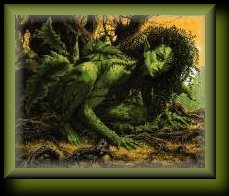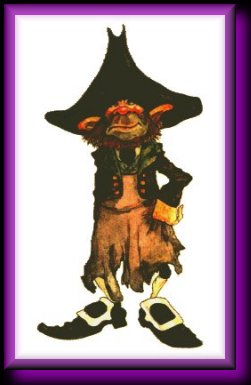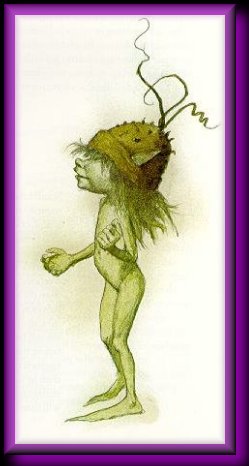
|
Faeries, also known as the Little People, the Green Men, the good folk, the Lordly Ones, and so on ... are the most magical and mystical of creatures. The belief that there is a seperate world known as fairyland is erroneous. The Faeries coexist with our world, which is fairyland enough for those who believe. The Faerie originated in Italy, where they were known as the fatae, which eventually changed to the more common name of Faerie. When Romans started emigrating, the faeries went along and settled throughout the same territories. A faerie generally assumes the form of a perfect miniature human being, usually about the height of a human hand. They can change size at will, sometimes fooling humans into believing that they are mortals. Contrary to popular belief, faeries do not posses the power of invisibility. All animals can see them and they will sometimes let themselves be seen (using their faerie power called glamour) by a human between two blinks of an eye. Sometimes you can spot a faerie during certain phases of the moon, such as a full moon on Midsummer's Eve. On such occasions you may find yourself looking at a faerie celebration but, don't watch too closely or for too long or else you may find yourself punished with moon-sickness. Faeries also possess the power of vertical and horizontal levitation along with faerie magic properly called glamour. Their glamour operates through a certain kind of thought power that mortals cannot understand. Faeries usually dwell in the forest or wilderness and most faeries are vegetarians. They enjoy fresh fruits, berries, honey, bird eggs, and other garden produce. They are very fond of cakes and pies. They don't like milk due to the thickness and prefer to drink dew or spring water. Faeries are not good cooks, so they tend to run off with the housewife's baking. The best way to prevent this is to mark the baking with a cross. Faeries have no problem comunicating with humans because they can adapt to and speak almost any language. The native faerie language often sounds like the twitering of birds or the gurgling of a stream. Faeries have a fierce love of flowers and take on the task of caring for them and helping them to grow. When faeries sleep they tend to sleep inside of flowers and this is the reason that they close up at night. The original function of faeries was to appear in a household soon after the birth of a child. If the faerie was treated with extreme tact and sensitivity the faerie would then grant the child special gifts such as beauty and tranquility. The goodwill of faeries may sometimes be as embarassing as faerie malice. There is a well-documented case of a faerie troop who decided to help a friendly farmer by bringing in his wheat harvest. He was astonished to find that his entire harvest had been reaped and stored overnight, but on subsequent nights the faeries also reaped the harvest of all his neighbours and stored it in his barns. He had a difficult time talking himself out of this demonstration of faerie generosity. Faeries are neither good nor bad, like mortals they change in mood and temperment but on the whole part they are festive creatures who desire to be left in peace. They only show thier more sinister aspects when confronted with the brutality of mortals. Faeries love to dance in circles in the grass. These circles are called faerie rings and mortals should be wary of them. They can be identified by the ring of mushrooms that they leave behind. One may be drawn in by the enticing faerie music and dance with them for what seems like minutes but in actuality may be several years. Faerie curiosity often leads to misunderstandings. It seems that faeries like to take items and discuss them with other faerie friends. When they bring things back they return it to a place slightly different from where they got it. This may explain lost items in the household. There are two distinct types of faeries. The first is the solitary faerie who almost always lives alone and only makes contact with other faeries during market where they sell the things they find throughout their travels. Solitary faeries usually tend to dress in red and often spends their long life traveling. The other type of faerie is called the troop faerie. They live in small colonies called troops, each induvidual troop is is headed by a queen and then the entire race is governed by Faerie Queen Titania and Prince Oberon. Queen Titania does most of the work and ruling and Prince Oberon acts as her mate and does not have much say in faerie rulings. Troop faeries like to make their homes in hollow hills or mounds of earth known as tumuli. Mortals are advised to keep away from these also. Troops faeries tend to dress mostly in green. |
|
|
 Dryads are nymphs of the trees. They are tree dwellers, they especially like to live in oaks. Dryads perform no special function except to enhance the beauty of nature. They very rarely allow themselves to be seen and will turn themselves into a sapling if they encounter a mortal. This explains the scarcity of information on them.
Dryads are nymphs of the trees. They are tree dwellers, they especially like to live in oaks. Dryads perform no special function except to enhance the beauty of nature. They very rarely allow themselves to be seen and will turn themselves into a sapling if they encounter a mortal. This explains the scarcity of information on them.
|
 Leprechauns are characteristically tricky, merry, and mischevious. Leprechaun means "the maker of one shoe".They make shoes for faeries and are never seen working on more than one shoe. Unlike faeries leprechauns can be spotted easily. Those who have seen leprechauns describe them as a merry little fellow usually wearing a green coat and shoes with big buckles. Leprechauns are fond of three-sided hats and can be spinning on them from time to time. They hibernate underground in the winter and emerge during the summer months.
Leprechauns also know the places of hidden gold which makes them so popular among mortals. But once caught a leprechaun cannot be held. Once you begin to interrogate him he always manages to escape. A leprechaun will very rarely give away the place of hidden treasure. There is one story where a leprechaun showed a farmer the only plant in an entire field of ragwort under which gold was buried. The farmer tied his red garter to the plant and went to fetch a shovel but when he returned every single ragwort in the field had a red garter tied to it. If you happen to spot a leprechaun before he sees you he usually becomes more co-operative and can be persuaded to show you the gold.
Leprechauns are characteristically tricky, merry, and mischevious. Leprechaun means "the maker of one shoe".They make shoes for faeries and are never seen working on more than one shoe. Unlike faeries leprechauns can be spotted easily. Those who have seen leprechauns describe them as a merry little fellow usually wearing a green coat and shoes with big buckles. Leprechauns are fond of three-sided hats and can be spinning on them from time to time. They hibernate underground in the winter and emerge during the summer months.
Leprechauns also know the places of hidden gold which makes them so popular among mortals. But once caught a leprechaun cannot be held. Once you begin to interrogate him he always manages to escape. A leprechaun will very rarely give away the place of hidden treasure. There is one story where a leprechaun showed a farmer the only plant in an entire field of ragwort under which gold was buried. The farmer tied his red garter to the plant and went to fetch a shovel but when he returned every single ragwort in the field had a red garter tied to it. If you happen to spot a leprechaun before he sees you he usually becomes more co-operative and can be persuaded to show you the gold. |
| Mimis are rock spirits who live in the hills of northern Australia. They Dwell in rock crevices and are consequently very thin, lithe creatures. The mimis only leave their homes in search of food. Their tastes include yams and other roots but if a mortal happens to be passing by they will eat him instead. They have to keep thier eye out for the weather because when the wind is blowing it will whisk them away. |
|
Nymphs consist of a large family of beautiful maidens who inhabit all larger plants and natural features of our earth. This family consists of several different branches with their own name, each take of or enhance different parts of our earth, for example: Dryads are the nymphs of the forest and the trees, the Napaeae are the nymphs of glens and groves, the Oreades are the nymphs of mountains and grottoes.
|
 The Pixies (sometimes called piskies or west country faeries) inhabit Cornwall, Devon, and Somerset; their origin is unknown. They are believed to be the earliest inhabitants of England. Pixies, like faeries, are no larger than a human hand but can change their size at will. Most pixies have green eyes, red hair and like to wear close-fitting clothes of green so as to blend in with the lush pastures of England. The pixie is a malicious trickster. Pixies like to throw pots and pans after kitchen girls. They also like stealing horses at night to ride them across the moor, they twist and knot their manes to spur them into circles called "gallitraps". Their favourite trick is to lead humans astray. Sometimes pixies may confuse mortals so thouroughly that they never recover and wander aimlessly through the countryside singing or talking a mysterious language. This condition is known as being "pixie-led". One can foil a pixie by turning their coat inside-out. Farmers can stay in good terms with pixies by leaving buckets of water out at night for pixie-mothers to wash their babies, leaving out a pitcher of milk for them to drink, and keeping the hearth swept clean for pixies to dance on at midnight.
The Pixies (sometimes called piskies or west country faeries) inhabit Cornwall, Devon, and Somerset; their origin is unknown. They are believed to be the earliest inhabitants of England. Pixies, like faeries, are no larger than a human hand but can change their size at will. Most pixies have green eyes, red hair and like to wear close-fitting clothes of green so as to blend in with the lush pastures of England. The pixie is a malicious trickster. Pixies like to throw pots and pans after kitchen girls. They also like stealing horses at night to ride them across the moor, they twist and knot their manes to spur them into circles called "gallitraps". Their favourite trick is to lead humans astray. Sometimes pixies may confuse mortals so thouroughly that they never recover and wander aimlessly through the countryside singing or talking a mysterious language. This condition is known as being "pixie-led". One can foil a pixie by turning their coat inside-out. Farmers can stay in good terms with pixies by leaving buckets of water out at night for pixie-mothers to wash their babies, leaving out a pitcher of milk for them to drink, and keeping the hearth swept clean for pixies to dance on at midnight.
|
| Red Cap is one of the most evil border goblins. He likes to live in ruined castles and watchtowers on the border between Scotland and England, particularly those with a history of wickedness. He has to shift his residence often to avoid attentions of excorsists, witch-finders and similar authorities. Red Cap can be distinguished easily; He is short with bright, firey eyes, a long grey beard and has eagle claws instead of hands. He wears iron boots and moves swiftly despite their weight but his most distinguishing feature is his blood red cap. Red Cap seeks human prey in order to renew the colour of his cap, which he dips in the blood of his victims. A wanderer along the border trails would be wise to avoid brooding piles of stone or ancient ruins in case it the temporary residence of Red Cap. To git rid of Red Cap before he attacks quote a couples of lines from the Bible, at the sound of those words he will immediately vanish. |
|
This page was created by Bluepixie, Copyright © 1997, 1998 Established August 1997 All picture frames and summaries created by Bluepixie, |

